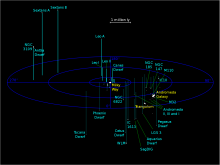Listen to today's episode of StarDate on the web the same day it airs in high-quality streaming audio without any extra ads or announcements. Choose a $8 one-month pass, or listen every day for a year for just $30.
You are here
Scorpius
There aren’t many constellations that really look like what they’re supposed to depict. And there aren’t many whose ancient names are easy to translate without a dictionary. But one that defies both trends is one of the highlights of summer’s evening skies: Scorpius, the scorpion. It’s low in the south as night falls right now.
Under even a moderately dark sky, it’s not hard at all to see the outline of a scorpion. Its “heart” is the bright orange star Antares. The scorpion’s head is formed by a short line of three stars to the upper right of Antares. And its body, tail, and “stinger” curl away to the lower left of Antares.
In ancient times, the scorpion was even bigger. Its claws extended far from the head. But more than 2,000 years ago, they were stripped away. Today, they form the constellation Libra, the balance scales. Yet a couple of its stars retain their scorpion names: Zubeneschamali and Zubenelgenubi — the northern and southern claws.
One reason that Scorpius shines so brightly is that it outlines one of the spiral arms of the Milky Way Galaxy. Clouds of gas and dust along the arm are giving birth to new stars. And many of those stars are especially big and bright. That makes the scorpion easy to pick out.
Many cultures have identified these stars as a scorpion. Many others, though, have seen a different but equally understandable pattern — a fishhook, luring prey across the Milky Way.
More about Scorpius tomorrow.






